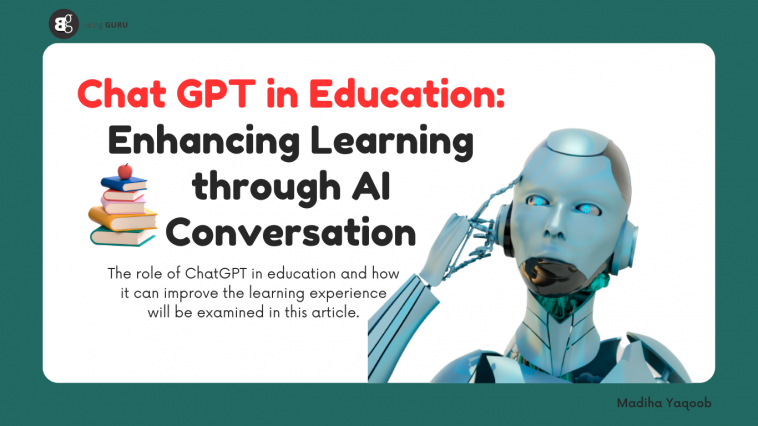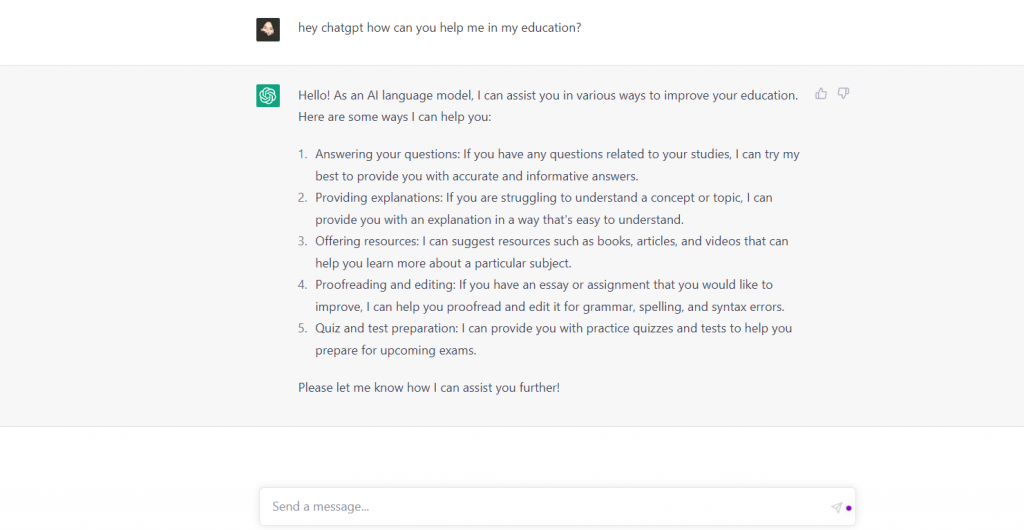Education is one of the many domains of human activity that is being transformed by artificial intelligence (AI). Chatbots and conversational AI platforms like ChatGPT are revolutionizing how students interact with educational resources, making learning more accessible, personalized, and engaging. The role of ChatGPT in education and how it can improve the learning experience will be examined in this article.
What is ChatGPT?
ChatGPT is an AI conversational platform developed by OpenAI that uses a powerful language model called GPT (Generative Pre-trained Transformer) to generate human-like responses to text inputs. With its capability to comprehend and address intricate queries, offer tailored responses, and generate novel text, it stands out as one of the most sophisticated chatbots obtainable.
ChatGPT is trained on a massive amount of data, making it capable of understanding context, detecting sentiment, and generating responses that are relevant and informative. With its myriad of potential uses across diverse industries, including education, it is an immensely powerful tool.
How ChatGPT is used in Education
ChatGPT is a valuable tool in education, providing students with an innovative way to interact with learning resources. Here are some ways ChatGPT is being used in education:
Virtual Learning Assistants: ChatGPT can serve as a virtual learning assistant, providing students with 24/7 access to resources and support. It can answer questions, provide feedback, and guide students through learning activities. By leveraging ChatGPT, students can receive personalized support, allowing them to learn at their own pace and in a way that suits their learning style.
Personalized Learning: ChatGPT can analyze student data, including learning preferences, performance, and feedback, to provide personalized learning experiences. Suggesting resources and activities aligned with the student’s learning requirements ensures that the necessary assistance is provided to help them achieve success.
Language Learning: ChatGPT is an excellent tool for language learning, as it can generate responses in multiple languages. It can assist students in refining their language skills by offering instantaneous feedback on their pronunciation, grammar, and vocabulary.
Homework and Assignment Support: ChatGPT can provide students with support for homework and assignments. It can offer illustrations, address queries, and steer students through the process of resolving problems. By leveraging ChatGPT, students can receive instant feedback, ensuring that they are on the right track and have a better understanding of the material.
Digital Learning Resources: ChatGPT can be used to create digital learning resources, such as interactive quizzes, simulations, and games. It can generate questions, scenarios, and feedback, making the learning experience more engaging and interactive.
Benefits of ChatGPT in Education
ChatGPT offers numerous benefits for both students and educators, including:
Personalized Learning: ChatGPT can analyze student data and provide personalized learning experiences, ensuring that each student receives the support they need to succeed.
24/7 Support: ChatGPT is available 24/7, providing students with access to resources and support at any time.
Improved Learning Outcomes: By providing personalized support, instant feedback, and engaging learning experiences, ChatGPT can improve learning outcomes and student engagement.
Accessibility: ChatGPT is accessible to all students, regardless of their location, ability, or background. Being accessible on any internet-enabled device, it proves to be an invaluable tool for distance and remote learning.
Cost-effective: ChatGPT is a cost-effective tool, as it can provide personalized support and feedback at scale, reducing the need for additional resources and support staff.
Challenges of Chat GPT in Education
Chat GPT also poses some challenges for education, such as:
– Ensuring quality and accuracy: Chat GPT is not perfect and may generate texts that are inaccurate, irrelevant, or inappropriate. Chat GPT may also lack domain-specific knowledge or expertise on certain subjects or topics. Therefore, chat GPT needs to be supervised and evaluated by human experts to ensure quality and accuracy.
– Maintaining ethics and safety: Chat GPT may generate texts that are harmful, offensive, or misleading. Chat GPT may also violate privacy or intellectual property rights by using personal or copyrighted information. Therefore, chat GPT needs to follow ethical and safety guidelines to protect users and stakeholders.
– Addressing bias and diversity: Chat GPT may reflect or amplify bias and stereotypes based on its training data or algorithms. Chat GPT may also exclude or marginalize certain groups or individuals based on their language, culture, or identity. Therefore, chat GPT needs to be inclusive and diverse to respect and represent all users and stakeholders.
Conclusion
ChatGPT is well-suited to the complexities of the education sector with its advanced language model and ability to understand the context. As AI technology continues to advance, we can expect ChatGPT and other conversational AI platforms to play an even greater role in education, transforming how we learn and interact with learning resources. However, it is important to remember that chat GPT needs to ensure quality and accuracy, maintain ethics and safety, and it should be used to complement and enhance the role of educators, not replace it. By overcoming these challenges, chat GPT can become a valuable tool for education in the 21st century.





